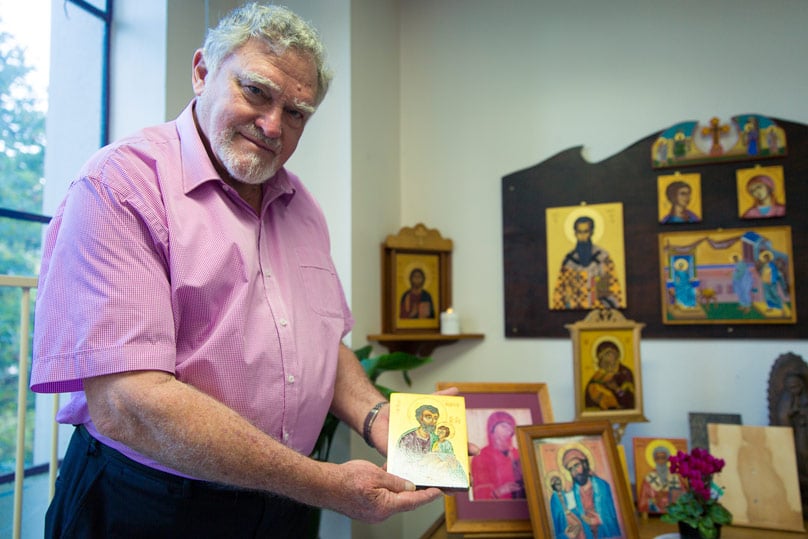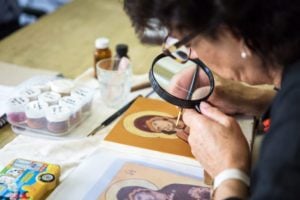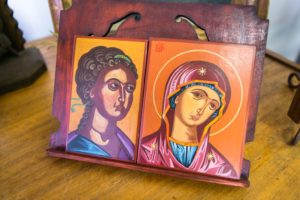
On the third level of Mitchell House–near the busy intersection of Lonsdale and Elizabeth streets–dedicated painters gather each week to pray and work.
They are members of the Icon School of St Luke at the Caroline Chisholm Library, operating since May 2002 and led by iconographer and woodworker John Daly.
While icons are the traditional style of religious art in Byzantine Orthodox and Eastern Catholic Churches, they have become increasingly popular in the West.
Described as “windows into heaven”, icons are the hinge between the mystical and the aesthetic (beautiful). From the atmosphere of the studio to the choice of the paint, each step in the process is as theological as it is artistic.
Western art is often understood in terms of “self-expression” or decoration, however icons are not interested in the individual expression of the artist, nor are they considered decorative, although they are beautiful.
An icon tries to do two things – speak a spiritual truth about its subject, and provide a gateway to contemplation.

The first eikon (or image) was said to be a miraculous imprint sent by Christ to King Agbar of Edessa. Tradition tells how the sickly king sent envoys to Christ, asking Him to visit and heal him. Christ sent his disciple, Thaddeus, with an imprint of his image on a cloth, which effected a healing.
This echoes the Western tradition of Veronica’s veil.
From King Agbar, there spread many traditions of “images made without human hands”. Much like the Psalms are to sacred music, these inspired images formed the basis of iconography.
To those new to icons, the symbols can be confusing. The figures are often not in proportion and the features are not symmetrical. Yet, these artistic conventions are used to make a higher theological point.
For example, the eyes are always large and the ears visible, while the mouth is almost oddly small.
This is to remind the viewer that it is more important to see and to hear, than it is to speak. In other icons, both eyes look directly at the viewer. This not only invites contemplation but outlines that the just man or woman can look you straight in the eye. Only the devil, the deceiver, is depicted in profile.
An icon is painted on a dark background, while the image is slowly bought out by adding successive layers of lighter paint. This makes the theological point that the holy person is illuminated by God’s light and also makes the profound aesthetic point that the artist mirrors the creative work of God – the first One to bring light from the darkness.

The primary purpose of the icon is to be the mystical gateway for meditative prayer. Viewers of icons are meant to become living icons – bearers of the image of Christ.
This beautiful transformation into eikon is summarised by Russian theologian Paul Evdokimov (1901-1970) who writes:
“It is not enough to say prayers: we must become, be prayer, prayer incarnate. All of life, each act, every gesture, even the smile of the human face, must become a hymn of adoration, an offering, a prayer. One should offer not what one has but what one is.”
This contemplative element is strong at the Icon School of St Luke. Each session starts with a prayer, and the iconographers often paint while fasting and listening to sacred music. It has become the hallmark of the School.
Another hallmark is the sheer talent of the artists.
Many of them artists in their own right, they each bring their gifts to the school. For example, Sally Fraser, who also works in watercolours, acrylics and ceramics, is fondly known as the “expert on halos”.
Pauline Kennedy has so mastered the technique of gold burnishing, taming the fickle gold leaf that her icons look as if they have been dipped in liquid gold. Beryl Georgakopoulos has the gift of capturing true beauty in the faces while remaining faithful to what is best in an icon; and John blends his extensive knowledge, talent and passion with a keen interest in woodwork, where he supplies wooden boards for the majority of the school.
In June 2015, the Icon School expanded to include a second class for beginners. Intermittently described as the “night group”, the “Monday group”; the “young group” or “the millennials”; each week between 5-10 young Melbournians travel to the Library to learn the sacred art.
These beginners were admitted into seeing the practical work that goes behind making “windows into heaven”, a process that can take up to several months. They were taught how to make their own egg emulsion (a mixture of egg yolk, water and vinegar); to mix paints using pure, raw pigment; and to prepare the boards (canvas) by a lengthy process including rabbit skin glue, chalk, painting and sanding.
John often says to his class, “you are not forgers, you are artists,” and welcomes creativity within the limits of the sacred art. This year, the St Luke School made small iconographic history, with John designing two icons of St Joseph that could be painted by the beginner class.
“The palpable love of, and devotion to, Saint Joseph in the younger evening group has led to the development of two new icons,” he said.
Taken from existing icons of St Joseph, these icons accompany the two other “learner icons” of Our Lady and the Archangel Gabriel, designed so that beginners would have a chance to get over the “fear of painting faces.”
“One is of Saint Joseph holding the stout staff which, according to one tradition, flowered as a sign that Joseph was the Divine choice for a husband for Mary. The other, which we have called Saint Joseph the Protector, depicts Joseph holding the Christ Child who clasps Joseph’s right hand in both of His.”
John speaks about how the blend of creativity and custom allows him true “freedom” in the classical sense.
“The iconographic insistence on imitation – following its long-established traditions – rather than unfettered innovation, leaving the mind free to pray while painting,” he says. John says that his “fervent hope” is that the last of the Rules for Icon Painting be “held firmly in the minds of all my iconographer friends.” These are:
- The joy of spreading icons in the world.
- The joy of the work of icon-painting.
- The joy of giving the Saint the possibility to shine through his icon.
- The joy of being in union with the Saint whose face you are painting.
The Icon School of St Luke is excited to announce that 2017 brings with it the commencement of four “new” icons. While Beauty might not save the world, it is certainly doing wonders for this glittering corner of Catholicism in Melbourne.
